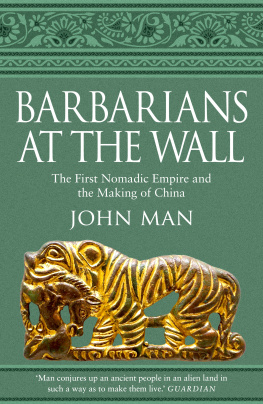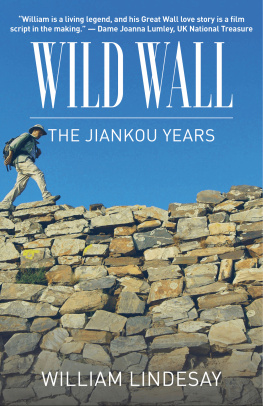Table of Contents
Also by John Man
Gobi
Atlas of the Year 1000
Alpha Beta
The Gutenberg Revolution
Genghis Khan
Attila
Kublai Khan
The Terracotta Army
A NOTE ON SPELLING
Most Chinese words in this book are names, and all except for the occasional very well-established one are transliterated using the modern system, pinyin (as opposed to the old one, known as Wade-Giles). In pinyin, most letters and diphthongs are roughly as in English, but some have their own pronunciation. These are the main ones:
Consonants:
c as in rats
q as in church
x is between s and sh
z as in suds
zh as in fudge
Vowels:
e as in the US pronunciation of nurse
ie as in yeah
ue as in a contracted form of you were ywere
eng as in sung
ei as in gay
Commonly, pinyin omits the tones that help define the Chinese character. In Mandarin, there are four tones, indicated with accents on the vowel (the first, in diphthongs):
First (high, level) tone:

Second (rising) tone:

Third (falling-rising):

Fourth (falling) tone:

Even so, pinyin cannot always specify the exact sign, so for the sake of Chinese speakers and translators I add the Chinese signs, except for proper names, which are so numerous that to give Chinese signs for all would be too cumbersome.
ACKNOWLEDGEMENTS
My thanks:
to those who eased the way in China and Mongolia: Y. Badral, Three Camels Lodge and Nomadic Expeditions, Mongolia; Batbolt, driver, Choibalsan; Cheng Yinong and Emma, Beijing; Cheng Dalin, Wall expert, Beijing; Goyotsetseg Radnaabazar (Goyo); Prof. Dr G. Jorigt, Mongolian Language Institute, College of Mongolian Studies, Inner Mongolia University; Li Yafen, Jinshanling; Ling Qin, School of Archaeology and Museology, Peking University; Luo Hong, driver, Dunhuang; Shagai, driver, Dalandzadgad; Franck Pelagatti, Paris; Shou Weijong (William), Beijing; Song Guorong, Yongchang; Sun Chingching (Christina) and Xu Jie (Eric), guides, Lanzhou; Prof. Tsogt-Ochir Ishdorj, Mongolian Academy of Science; Ms V. Urzhing-khand, Chingisin Dalan, eastern Mongolia; Wong Qinglin, Dunhuang; Xu Zhaoyu (Michael), Hai Tian Travel Service, Lanzhou; the staff of the Yanguan Museum; Zhang Min, Badaling; Zhou Wangping, Jinshanling;
to those who helped the flow of information: Rafe de Crespigny, Faculty of Asian Studies, Australian National University; Robin Darwall-Smith, Magdalen College, Oxford; Prof. Glen Dudbridge, University College, Oxford; David Harris, Mount Barker, South Australia;
and, as always, to those who made the book happen: the team at Transworld Doug Young, Simon Thorogood and Sheila Lee; Malcolm Swanston and Jonathan Young, Red Lion Maps; Gillian Somerscales, for superb editing; and Felicity Bryan and her wonderful staff.
INTRODUCTION
THE WALL OF CHINA DOES NOT EXIST
If Hollywood ever makes The Great Wall: The Movie, it might open with this single, uncut, aerial tracking shot, in Imax:
EXT. EARTH ORBIT. DAY
Below us, as the earth turns, India vanishes off-screen left, and east Asia swings into frame. Were
FALLING TO WARDS CHINA.
LCD displays flicker:
Altitude: 15... 14... 13 kilometres.
Speed: 3,000... 2,750... 2,500 kilometres per hour.
Colours emerge: the green of the fertile south, the burned brown of the desert north, Tibets white highlands. Altitude: 8... 7... 6 kilometres. Speed: 1,500... 1,250 kph. Now two great rivers stand out, and north of them a dark, wavy line cutting across the whole region, from deserts to our left, over mountains to the blue Pacific. Height: 1 kilometre; speed: 1,000 kph. We level out over a river and stark brown mountains, and
ZOOM IN
on the dark, wavy line, which is not a wavy line any more, but the Wall, immense, a river of stone 7 metres high, wide as a road, reaching to the horizon in both directions, with a watch-tower every kilometre. Soldiers on the battlements are running to the towers, where they are starting warning fires. Beyond, a nomad horde assaults the Wall, to no effect. We turn along the Wall at the speed of sound. From each tower in turn, flames and smoke leap, as if unzipping the desert. We overtake the dots of flame. On our right, a great chain of snow-capped mountains flickers past. On the left, more mountains, austere ones of dark rock. They close in on either side. We pop through the gap, always above the Wall, then weave through more mountains to a vast, muddy river. The Wall edges the river, veering into a semicircular turn. Now the landscape changes. Its greener. The Wall begins to zoom and twist round and over mountains. We follow in an exhilarating roller-coaster ride. In the distance to our right, beyond the mountains, a huge city. Its past, and the Wall runs onwards, up, down, left, right more mountains, a lake, a final leap up and over, and ahead is a fortress where the Wall plunges into the sea.
ZOOM
upward into blue sky.
CUT.
Thats how it might begin. It would indeed be wonderful, with all those expensive, impossible computer graphics. It would, I think, seduce an audience. They would believe, because they have seen the images of the Wall near Beijing, which looks pretty much like a bit of the Wall in this epic opening. They would believe, because it confirms so much they think they know about the Wall: the only man-made structure visible from space, it runs in an unbroken line of stone across north China, it was built to keep the barbarians at bay, etc., etc.
They would believe. But they would be wrong, because the sequence is almost entirely rubbish. A more accurate title for any film that began this way would be The Great Wall: Errors, Lies and Assorted Idiocies.
No, it cannot be seen from space. That quaint idea came from an even quainter one, stated as fact by Robert Ripley, the American illustrator who made himself a millionaire with his cartoon feature Believe It Or Not ! This specialized in making extraordinary claims, some true, some as fantastic as headlines in a downmarket tabloid Astronomers Discover Pearly Gates, Nun Gives Birth to Puppy: that sort of thing. The feature became an industry, syndicated, turned into radio and TV shows and films, reproduced in books. As a child, I had one of Ripleys books. It showed a man lifting weights with his eyeballs, which I totally believed. In the 1930s, when Ripleys feature took off, he had 80 million readers. You can still see reruns of the films on the Sci-Fi Channel, which is where most of the outrageous claims belong, including the one that called the Great Wall The mightiest work of man the only one that would be visible to the human eye from the Moon. This statement was, of course, founded on no evidence at all, since it was made 30 years before anyone had been in space, 40 before the lunar landings. This didnt prevent its becoming sanctioned by use: so much so that the eminent Sinologist Joseph Needham, author of the magisterial multi-volume
























